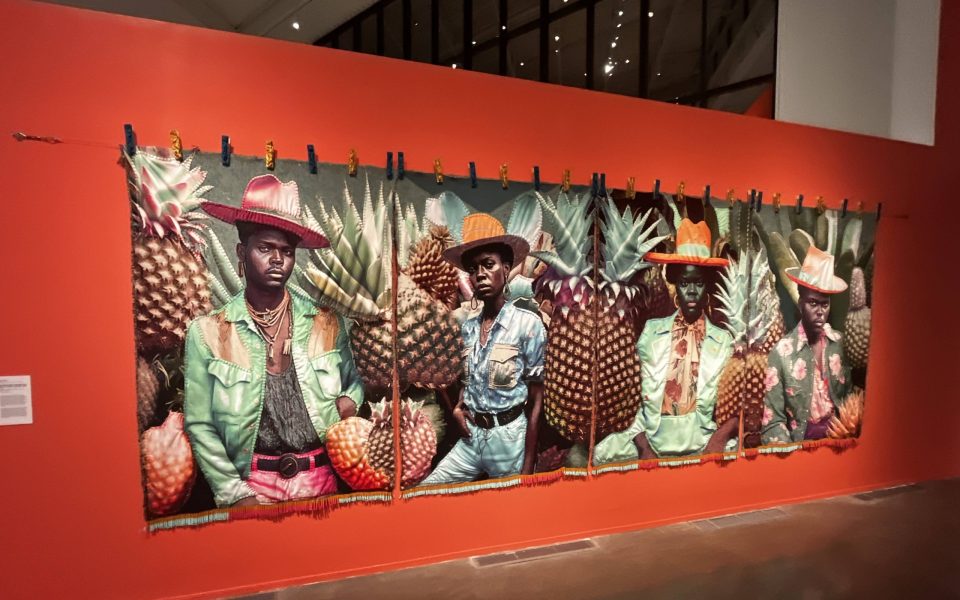Featured photo: April Bey’s “Me Personally? I Wouldn’t Let Anyone Talk to Me Like That,” portrays steadfast Black portraits set against luscious fruit and tropical surroundings. (photo by Harry Turfle)
Imagine a planet called Atlantica, a paradise where Black people flourish, absent from the legacies of white supremacy, colonialism, and homophobia. Beautiful people, multifaceted in their gender expressions, are surrounded by giant, luscious pineapples and stare out across the land like tropical fashion models from the future. This is the Afrofuturist vision that Bahamian American artist April Bey has sewn together using colorful textiles and sherpa blankets, which hang off of the museum walls via big chunky clips.
The new show, The Threads We Follow, is now on display at SECCA in Winston-Salem and features 11 artists: four from North Carolina, and several others who are certified international hot commodity art stars. Using different forms of textiles to tell personal and global stories, the works are provocative and experiments with the theme of interconnectedness which takes viewers on a journey around the globe while keeping them firmly rooted in the Triad.
“When we look at fiber, it’s so related to identity,” explains Maya Brooks, assistant curator of contemporary art at SECCA and the North Carolina Museum of Art. “There’s a history behind it and artists want to explore that history now.”

The show has been in Brooks’ head since she first fell in love with the artist Annie Greene’s yarn art at 14 years old. Now, 13 years later, the idea exploded when she saw a piece by Jamaican artist Ebony G. Patterson at an art fair. That piece, called “…when the crisis takes root…,” acts as the centerpiece of the show and was the first work selected for it.
It’s a shimmering magic carpet of a thing, unfurling across the gallery with glitz, glitter and transitive symbolism from the Caribbean. At one end is a black peacock standing on golden conch shells with drapes of colorful beaded macrame and folds of a sequined forest blanket undulating to the back, where two translucent legs stick out, reminiscent of The Wizard of Oz, but with one shoe thrown tragically off. Snakes hide within the fabric, and the whole shimmering spectacle seems to float on top of an army of red-gloved hands. Sparkly and dark, the piece contradicts what many may think of when they hear the term “fiber arts.”

Because fiber arts is a broad category that includes functional work like clothing as well as fine art, museums don’t always welcome the medium. Historically, textiles were seen as domestic mediums used by women and people of color in the home. That devaluing of the artform has, over time, reinforced the historic oppression of women and Black and brown people by labeling their creative labor as less important than traditionally elevated mediums like oil painting and sculpture. But a new generation of fine artists is using sewing, weaving and fabric-making as tools of change, empowerment and artistic expression. And they have the attention of museums.
“This show is so global because I wanted people to see there are so many threads that connect us all,” says Brooks. “We can bring people from the Bahamas and Mexico and Jamaica and Cuba and Ghana and connect them with folks who are right here in Raleigh and Winston. it matters that we’re all thinking about these things and it’s on a global scale.”

In addition to Patterson’s stunner, tapestries made of human hair, draped fabric with historical photos and a powerful mask made of bullets by Lakea Shephard, an artist from Winston-Salem, grace the gallery.
Shephard, whose mother worked at a Hanes Fabrics factory for 30 years, now creates ornate masks from stones, beads, fabric and other objects, including bullets, dolls’ hands and gold foil. The powerful objects transform the legacy of African-American struggles into intricate beauty and muzzled possibilities. The vision of a mask resting on a pedestal then transposed on a model in a nearby photo evokes the gulf between the lived experience of objects in use and the art that’s seen in galleries but never touched.
And that gap is something that Brooks was keenly aware of when crafting the show.
“All of the works in this show use materials in a different way,” says Brooks. “It’s about the experience. You don’t just walk up on it and think textile because there’s so much going on that defies expectation.”
The Threads We Follow is on display at SECCA through March 10, 2024.
Join the First Amendment Society, a membership that goes directly to funding TCB‘s newsroom.
We believe that reporting can save the world.
The TCB First Amendment Society recognizes the vital role of a free, unfettered press with a bundling of local experiences designed to build community, and unique engagements with our newsroom that will help you understand, and shape, local journalism’s critical role in uplifting the people in our cities.
All revenue goes directly into the newsroom as reporters’ salaries and freelance commissions.


This is such a beautiful piece!!! Love the way the art is described for us. We are so lucky to have a curator like Maya Brooks in the triad making these connections and bridging local and global. Like this is a big deal!! Thank you to the writer for taking the time to highlight this exhibition,
The artists and the curator. More art writing like this !!!!